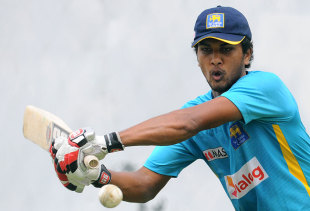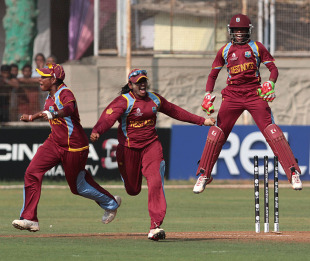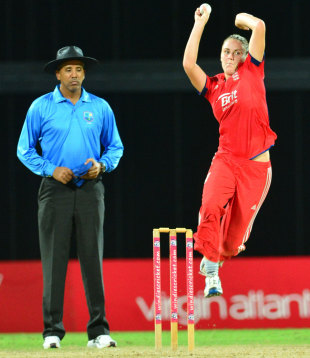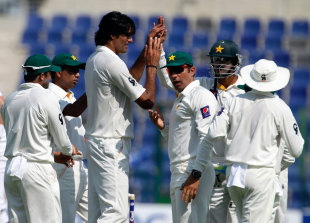The Sri Lankan board's continuing ineptness meant a paucity of Tests, alienation of senior players, and another cancelled T20 league
Andrew Fidel Fernando December 27, 2013

The 4-1 ODI victory over South Africa was one of the few positives for Sri Lanka in 2013 © Associated Press
If Sri Lanka's 2013 had remained as the Future Tours Programme had intended, fans would now be reflecting on a satisfying year of cricket, replete with full tours to the West Indies and Zimbabwe, and a home Test series against the No. 1 team. Instead it has been 12 months of bland, already forgotten ODIs and regret over missed opportunities. Fittingly, off the field, 2013 was the year in which the administrators, who allowed this scheduling travesty to occur, became a national joke.
Sri Lanka Cricket's bumbling took great many forms in the year, but nothing quite showcased its ineptitude like the cancellation of the Sri Lanka Premier League after the South Africa Tests had been postponed by two years specifically to make room for it. Three weeks before the SLPL was scheduled to begin, all eight franchises had effectively refused to pay their tournament fee and failed to produce bank guarantees for player payments.
The board claimed it had called off the tournament to safeguard "the integrity of the board and the integrity of the tournament". Given at least one Indian franchise owner was in the SLPL largely to fix matches, integrity had fled in the other direction long ago, like so many cricket fans who allowed the 2012 SLPL to be played in mostly empty stadia. (During this year's Indian Premier League, Ruhuna Royals owner Gaurav Rawat had approached Royals captain Lasith Malinga about fixing in the SLPL - an encounter which Malinga immediately relayed to the ICC's anti-corruption unit. In August, Rawat was among those slapped with corruption charges for their involvement in the Bangladesh Premier League.)
The removal of Tests from this year's calendar had far-reaching consequences beyond simply swindling fans and players of meaningful cricket. The selectors had sought to make 2013 a year of regeneration, but as few Tests were on the horizon, they were forced to blood young players in formats and positions their cricket is grossly unsuited for. Dinesh Chandimal and Lahiru Thirimanne would ideally be Test specialists at this phase of their development, yet they have both been asked to finish innings in ODIs and they have failed abysmally down the order, despite their obvious talent. As the World Twenty20 approaches, captain Chandimal has averaged 9.28 with a strike rate of 77 in 2013.
Rangana Herath waited a decade to secure a long stretch in the Test side, but now, at the peak of his powers he finds there are no matches to play. Kumar Sangakkara has been prolific in limited-overs cricket this year and had the schedule remained unchanged, he may have embellished an already monumental record. Test specialist Thilan Samaraweera retired from cricket because he could not wait six months for the next chance to play, and Test wicketkeeper Prasanna Jayawardene resorted to playing club cricket in England. It bears repeating too that South Africa's last series loss away came in Sri Lanka, and their 1-4 loss in the ODIs is some indication of their enduring discomfort against spin in Sri Lankan conditions.
The board's ongoing financial woes have affected just as many sweeping detriments to cricket in the country. An ugly contracts dispute between SLC and 23 top cricketers led to the players being locked out during a 24-hour impasse, less than a week before a Test match in March. SLC made moderate grants for domestic cricket development late in the year, but the first-class system remains riddled with bad pitches that produce mediocre cricketers, and the board cannot afford to enact the changes that are so desperately required if Sri Lanka are to remain a competitive Test nation.
" Among the few positives for SLC in the year has been their belated recognition of cricket's potential to aid reconciliation in the post-war north
Secretary Nishantha Ranatunga recently defended the building of stadia that landed Sri Lanka in their present fiscal nightmare by claiming the board was acting in the public's interest - not simply its own. Even cursory inspection exposes the feebleness of this proposition. SLC's primary mandate is to protect and promote cricket in the country, but by incurring huge debts, it has been in a profoundly poor position to do either. To its credit, however, at least the austerity measures it has put in place have helped wipe $12 million off its debt to the state bank.
Among the only specific recommendations of 2012's Lorgat review (which a year on, seems little more than an expensive sham), was the suggestion that team selection be bereft of political influence. Not only has the board failed to remove the sports minister from the selection process, as it promised it would attempt to do, the whole body has drunk even deeper from the diseased waters of Sri Lanka's political landscape.
For the second year in a row, Ranatunga was elected unopposed to what should be a highly contested position at the board, and allegations that he is consolidating power within the cricket body are rife. Sri Lanka's Rugby Football Union is perhaps the only sporting body that is more entwined with the ruling government than cricket, and in December, the SLRFU's president, Asanga Seneviratne, was installed as a vice-president at SLC. This is a man who two months prior had said that "in the next decade or so, [rugby] will overtake cricket" as the most popular sport in the country. His appointment is not the first major conflict of interest at the board, and if the current political milieu persists at Maitland Place, it will not be the last.
Among the few positives for SLC in the year has been their belated recognition of cricket's potential to aid reconciliation in the post-war north. Thirty concrete nets were built in school grounds in partnership with a charity, and the city of Jaffna received its first turf wicket, thanks largely to chief selector Sanath Jayasuriya's insistence. The board also announced that five cricketers from the north and east provinces will be awarded central contracts, helping clear the path for future professional cricketers from those regions. In addition, domestic cricket has begun to be broadcast on live television this year, raising its profile and allowing fans access to rising players at a time when the top team has itself been searching for replacements from the local leagues.
Sri Lanka's returns on the field have largely been acceptable, without revealing all that much about the state of its future prospects. Three encouraging fifties from young batsmen in the New Year Test suggested a future beyond Tillakaratne Dilshan, Mahela Jayawardene and Sangakkara may not be all that bleak, but the Bangladesh tour in March was not as informative. In ODIs, Sri Lanka drew three bilateral series, won one and lost another, in addition to making it to the semi-finals of the Champions Trophy and the final of the tri-series in the Caribbean. They also won six T20s out of nine - just enough to safeguard their top ranking in the format.
High point
The home ODI series victory against South Africa was Sri Lanka's best effort this year, particularly as the first two wins came in the absence of regular captain Angelo Mathews. South Africa rarely stretched the hosts during the 4-1 drubbing, and Dilshan and Sangakkara underlined their continuing hunger at the top level by hitting 645 high-impact runs between them.

If players like Dinesh Chandimal can succeed in the upcoming Tests against Pakistan, Sri Lanka will be able to survive the retirements of Sangakkara and Jayawardene © AFP
Low point
SLC's abysmal relationship with some of Sri Lanka's senior cricketers was laid out in public during the board's spat with Sangakkara over his representation for the Champions League. The board had attempted to cast Sangakkara's choice over whether to play for Kandurata Maroons or Sunrisers Hyderabad as a country versus money issue, which Sangakkara took exception to. The parties eventually made up in public after Sangakkara chose to play for Kandurata - perhaps in order to secure the high moral ground from which he launched his public attack - but distrust lingers, just as it did in the aftermath of Mahela Jayawardene's run-in with the administration at the end of 2012.
New kid on the block
Though the quest for regeneration has consumed the selectors' thoughts since they took office in February, it was an ODI at the end of the year that produced one of the brightest sparks. Right-hand middle-order batsman Ashan Priyanjan has had fine returns in List A and first-class cricket for more than 12 months now, but on debut against Pakistan on Christmas day, he showcased economical but precise footwork, an array of sound aggressive shots - largely played off the back foot - and he tied it all up with encouraging moxie against perhaps the best ODI attack around.
At the top of the innings, Kusal Perera has played some staggering knocks in the year; though equally, he has been plagued with inconsistency. There appear to be no major weaknesses in his game, for he defends almost as well as he attacks, but better judgement and a keener temperament might see him fully emerge from his novelty tag as a Jayasuriya carbon copy, and forge a destiny of his own.
What 2014 holds
The Test series in Pakistan will be a barometer of Sri Lanka's future prospects, and the true state of the young middle order's batting prowess. If the likes of Chandimal and Thirimanne can succeed in the UAE Tests, their limited-overs transgressions can be overlooked. If they fail in January and in the two Tests against Bangladesh soon after, the selectors may give some thought to looking elsewhere for a future-proof middle order.
The most high-profile fixture will be the tour to England in May and June. It should have been more conspicuous still, but the removal of one home Test against England in 2012 has meant that the reciprocal tour next year has been trimmed to two Tests as well. That series will perhaps be a defining one for the emerging fast-bowling trio of Shaminda Eranga, Suranga Lakmal and Nuwan Pradeep.
It will also be a year in which Mathews' skill as captain is put to test. He has had ten months to break into the role now, and while it is unfair to expect him to follow in Jayawardene's footsteps as a leader, he must omit the kinds of tactical errors that have occasionally burnt Sri Lanka this year. His own form with the bat will also need to become more consistent across all formats, particularly as Sri Lanka lock down their team combination for the 2015 World Cup.





















